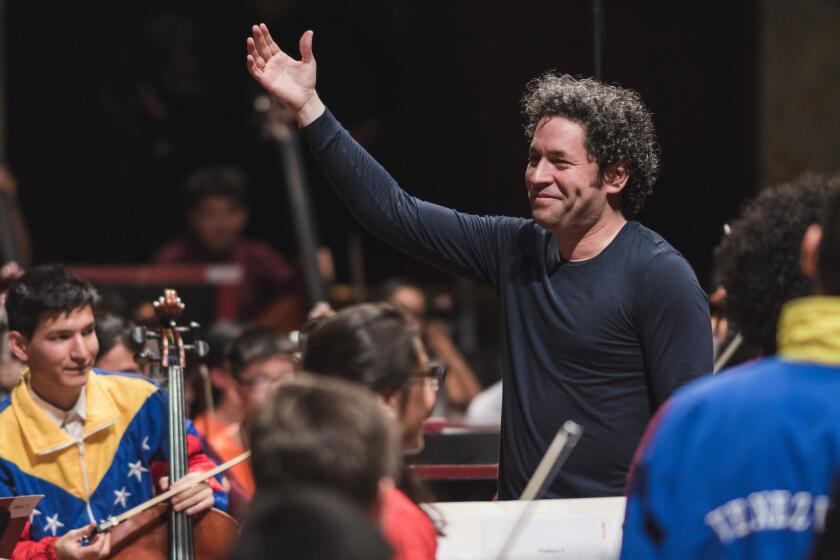S.D. Stadium an Unheralded Masterpiece
- Share via
SAN DIEGO — Except for Oakland and Los Angeles, the baseball season is over. On a warm week day, San Diego Jack Murphy Stadium is empty. Yet, even without the people, there is tangible energy.
Concrete rises in dramatic geometric patterns. As the sun sweeps across the sky, patterns of light and shadow on the gray surfaces change constantly. Walking up inside dramatic circular ramps to reach the upper levels, looking at the sky overhead, is an experience that makes the skin tingle.
On a few occasions, the stadium has been recognized as a masterpiece, but, for the most part, it remains one of San Diego’s unsung architectural heroes, a giant of the design world largely unheralded by San Diegans.
In 1979, architecture critic John Pastier reviewed the West Coast’s six stadiums for New West (now California) magazine .
“No other ballpark, old or modern, has matched the boldness and sensitivity of this stadium’s design,” he wrote. “Architectural and structural form are smoothly integrated and dramatically expressed, and even such problem elements as the lights and scoreboard have been skillfully made part of the sculptural composition.”
Pastier rated it “the champion,” better than Anaheim Stadium, Dodger Stadium and even the much newer Kingdome in Seattle. It may be the only stadium to win a national American Institute of Architects Honor Award.
Recently, architect R. Gary Allen, the stadium’s designer, revisited his most prominent piece of work in San Diego.
Allen has always kept a low profile. These days, even most of his peers are never quite sure what he’s up to. Yet he has done some of San Diego’s most innovative homes, and hopes he will soon be designing new stadiums in other cities.
He was 37 years old, a staff designer for Frank L. Hope & Associates, when this job fell in his lap.
Hope, then as now one of the city’s largest firms, received the commission, but as is common at big offices, the actual design would fall to one of several young staffers. Several were asked. None was interested. Allen claims he was the last man offered the job, and he immediately jumped at it. He already knew what he wanted to do.
“As an architect, I had thought about what a stadium should be,” Allen said as we walked up inside one of the spiral ramps, pausing occasionally to look down the center to where people come flowing in on game days. “A good architect should know the three or four best ways to do the major building types--museums, libraries, city halls, office buildings.
“I wanted to segregate the parts: services, seating, vertical circulation. The other stadiums had all joined these in one structure, but that left no design interest in each piece.”
Allen said he spent many long nights sweating details. He and 50 staffers took a whole floor of a downtown high-rise, and he remembers watching the sun set, then rise on the other side of the building a few adrenalin-soaked hours later--this deadline-crunching design was accomplished in only 90 days.
The architect made access routes to the stadium a visible design feature. The six spiral ramps were placed symmetrically around its edge. From a distance, they are reminiscent of Frank Lloyd Wright’s Guggenheim Museum in New York City.
Concrete-enclosed escalators, instead of being hidden away somewhere, jut out with bold diagonals that sweep to the ground.
For the most part, Allen is a pure rationalist. He doesn’t like anything phony or extraneous on his buildings. Yet like a great writer, he knows when he can get away with breaking the rules of architectural grammar.
So he decided to enclose the free-standing square elevator shafts in round concrete cylinders. And, though they weren’t structurally necessary, he added delicate concrete footings beneath the massive exterior columns. These symbolically link the stadium to the ground.
The easy way to finish the tops of the railings that circle the stadium would have been to just square them off. But Allen had worked with concrete, and he knew its power for manipulating light and shadow. He gave the railings a delicate bevel. The shadow line it creates helps give the building scale.
Designing a stadium to contain both baseball and football games is a mind-bending task.
“It’s like putting a shoe-box footprint and a piece of pie together,” Allen said.
But he had seen a shape called a “super circle” in a Scientific American article. Resembling a rounded-off square, the shape looked like a perfect way to keep both baseball and football fans close to the action. When it came to lighting, Allen did not want giant steel skeletons towering over his subtle concrete sculpture. So he designed precast-concrete lighting fixtures. These were assembled on the ground and lifted into place on top of the stadium by giant cranes.
“General Electric said the lights were too low. I told ‘em they were crazy,” Allen recalled. “I can remember standing here in the dark, seeing the lights turned on for the first time, being amazed at how good they were.” Allen said he was the first with built-in lighting. Now many stadiums have it.
Like any visionary, Allen faced naysayers. Several times, both the client (the city of San Diego) and his co-workers wanted to replace his bold exterior ramps with conventional forms.
He simply told them it wouldn’t be architecture without them. When workers began applying yellow, orange, magenta and green to concrete block, city officials were alarmed.
“Are you sure those are the colors you want?” one asked. Allen said they were.
“But you can see them from the road,” the city’s man protested.
Exactly the point.
Like any perfectionist, Allen finds faults with the stadium, especially how it’s been treated over the years.
New colors selected by San Diego architects Austin Hansen Fehlman to “spiffy it up” for this year’s Super Bowl are “trendy. They’ll be out of fashion soon. They changed the color and proportions of the building, especially the ramps.” The new colors don’t even define the structure. Different colors are used to break up forms which should be perceived as one piece, while those which should be defined as separate are done in the same color. Two tacky burger stands added over the years also have the architect singing the blues.
He would have handled the recent expansion, designed by C. W. Kim of Hope’s office, in a different way. By using a steel skeleton instead of solid concrete, spectators might still have some views of San Diego.
A World Series has been played here, as have Chargers’ play-off games and of course the Super Bowl, yet the stadium doesn’t seem to have the national name recognition of, say, Mile High Stadium in Denver, Wrigley Field in Chicago or the Pontiac Silverdome in Michigan. Allen thinks he knows why. It’s the name. “Jack Murphy was not the person most influential in getting the stadium done,” he said. “(Mayor) Pete Wilson picked the name, and it hasn’t helped. Pacific Ocean Stadium or some other name would be better, but then they never ask architects about those things.”
DESIGN NOTES
While UCSD is praising its new campus master plan by the Bay Area office of Skidmore Owings Merrill, there are skeptics. One well-known local architect says it has little to do with San Diego’s unique climate, that it’s far too formal and old fashioned, and that it fails to take into account the casual college life style and the gentle rolling terrain of the campus. . . . CCDC is offering density bonuses to developers in its Columbia area for rooftop gardens, “articulated” roof lines and exteriors that are less than half-covered with glass, preferably the kind that’s not too reflective. . . . Despite its pricey space, the San Diego Design Center being built on Shoreham Place in the Golden Triangle, designed by Johannes Van Tilburg & Partners of Los Angeles, is 40% leased. Space costs $1.35 to $2 per square foot. Exotic plants are already being grown for a 2-acre garden showcase for outdoor furniture. . . . The La Jolla Town Council is sponsoring its second “Coastline Workshop” Saturday, Oct. 22, in the recreation center at 615 Prospect St. A coastline walk will be followed by a workshop under the direction of local landscape architect Andy Spurlock and San Francisco coastal planning and community participation expert Peter Brand.
More to Read
The biggest entertainment stories
Get our big stories about Hollywood, film, television, music, arts, culture and more right in your inbox as soon as they publish.
You may occasionally receive promotional content from the Los Angeles Times.










